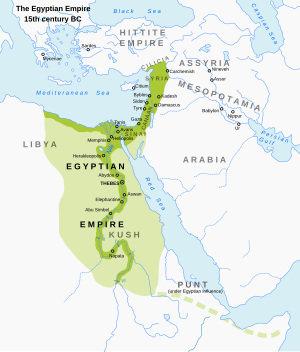Eighteenth Dynasty of Egypt | |||||||||||
|---|---|---|---|---|---|---|---|---|---|---|---|
| c. 1550 BC–1292 BC | |||||||||||
 The Egyptian Eighteenth Dynasty's empire at its greatest territorial extent under Thutmose III | |||||||||||
| Capital | Thebes, Akhetaten (1351–1334) BC | ||||||||||
| Common languages | Middle Egyptian (to c. 1350 BC) Late Egyptian (from c. 1350 BC) Canaanite languages Nubian languages Akkadian (diplomatic and trade language) | ||||||||||
| Religion | Ancient Egyptian religion Atenism (1351–1334) BC | ||||||||||
| Government | Absolute monarchy | ||||||||||
| Historical era | New Kingdom of Egypt | ||||||||||
• Defeat of the Fifteenth Dynasty (expulsion of the Hyksos) | c. 1550 BC | ||||||||||
| c. 1457 BC | |||||||||||
| c. 1350–1330 BC | |||||||||||
• Death of Horemheb | 1292 BC | ||||||||||
| |||||||||||
The Eighteenth Dynasty of Egypt (notated Dynasty XVIII, alternatively 18th Dynasty or Dynasty 18) is classified as the first dynasty of the New Kingdom of Egypt, the era in which ancient Egypt achieved the peak of its power. The Eighteenth Dynasty spanned the period from 1550/1549 to 1292 BC. This dynasty is also known as the Thutmoside Dynasty[1]: 156 ) for the four pharaohs named Thutmose.
Several of Egypt's most famous pharaohs were from the Eighteenth Dynasty, including Tutankhamun, whose tomb was discovered by Howard Carter in 1922. Other famous pharaohs of the dynasty include Hatshepsut (c. 1479 BC–1458 BC), the longest-reigning woman pharaoh of an indigenous dynasty, and Akhenaten (c. 1353–1336 BC), the "heretic pharaoh", with his Great Royal Wife, Nefertiti. The Eighteenth Dynasty is unique among Egyptian dynasties in that it had two queens regnant, women who ruled as sole pharaoh: Hatshepsut and Neferneferuaten, usually identified as Nefertiti.[2]
- ^ Wilkinson, Toby (2010). The Rise and Fall of Ancient Egypt. Random House. ISBN 978-0-679-60429-7.
- ^ Daniel Molinari (2014-09-16), Egypts Lost Queens, archived from the original on 2021-12-21, retrieved 2017-11-14